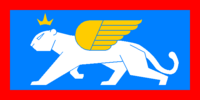Ilxanate

| |
| Type: | 1) Snorist dictatorship 2) Elected monarchy |
| Established: | 1951, self-bestowed |
| Recreated: | 1991, by election |
"Ilxan" is the title of the Head of State of Turkestan. Originally it was a Turco-Mongol title meaning "Subordinate Xan (Khan)"; Hulagu Ilxan was the founder of the original dynasty, and Timur is reputed to have used the title on occasions (though this last may be an EBÜK-era piece of propaganda fiction).
In modern Turkestan, the title has been revived and undergone a couple of shifts in meaning.
Snorist Ilxanate
It was Jalan Quyrat-ulı, the first Snorist ruler of Turkestan, who recreated the defunct title in 1951 as a way of adding the appearance of legitimacy to his rule. Any ideas of subordination left in the meaning of the title on his accession were quickly erased; Jalan Ilxan ruled as an autocrat and kept as much power as possible concentrated in his own hands. He did not relinquish control at any point before his death in 1969.
After his passing, the inner Keņes was thrown into turmoil. There was a period of bloody power struggle between various factions, and eventually Mızar Aman Beğ-ulı came out on top and was proclaimed Ilxan. The one saving grace of the interregnum was that outright violence was more or less confined to the Keņes and for the most part did not spill over into the society at large.
Mızar Ilxan ruled until his death in 1980, whereupon the Keņes, anxious to avoid the protracted and violent jockeying for position, selected Hamra Maxambet-ulı to become Ilxan. The selection process worked in the short term; the second interregnum was filled with cutthroat Macchiavellian political wrangling, but the actual cutting of throats was avoided this time. However, Hamra Ilxan was ousted from his position in 1984 by an internal coup d'etat, and Raza İris Baı-ulı claimed the Ilxanate. He remained in power until his unexpected death three weeks after the dissolution of the Russian SNOR was announced.
Raza Ilxan's death caught the Keņes completely by surprise. Not only had he been seemingly healthy, but he had just "replaced" most of his inner Keņes in one of the bloody loyalty purges for which Snorist Turkestan was so notable.
None of the younger, inexperienced survivors of the purge were strong enough or established enough to claim the supreme power for themselves, but neither were they willing to cede the Ilxanate and its power to one of their fellow Keņesçis either. The wider political climate was tense and unsettled; the Homeland Security Force had been quietly quelling pro-democracy demonstrations on an almost weekly basis for some time, and even they were beginning to question the status quo. If anyone were to attempt the usual violent political machinations for power, it would likely bring the whole house crashing down, and Russia would no longer be there either to hold things together or to pick up the pieces afterwards.
Turkestan waited while the Keņesçis weighed their desire for power against their desire for survival. Had any one of them been stronger or more established in their position, or had Raza Ilxan's purge been a less recent memory, there might have been a bloodbath. But as it was, the desire for survival won out. On 30th January 1990 (1989 in Turkestani reckoning) the Keņes announced that it was disbanding the EBÜK party apparatus and dissolving the Keņes itself pending free and open elsections to a new Keņes that would rewrite the Turkestani constitution as its first duty.
Modern Ilxanate
The newly elected Keņes chose to keep the position of Ilxan as Head of State, but with vastly reduced powers, and a modified and codified procedure for selecting a new Ilxan in order to try to prevent the bloody interregnal jockeying for position that had been a feature of high-level Snorist Turkestani politics.
Drawing inspiration from the Holy Roman Empire, as well as the way new rulers were chosen in the period before the first Russian conquest, they made the Ilxanate an elected monarchy, with the Keņes functioning as Electors. The Ilxan could be chosen from among the members of the traditional nobility, or from among the sitting members of the Keņes. Since these usually hold the rank of at least Bii, it amounts to more or less the same thing, but it means that a competent Keņesçi can be made Ilxan despite having a Qara Süyük (commoner) background.
This last is particularly based on the loose system by which Xans and Emirs were chosen in pre-Russian Central Asia, especially among the nomadic peoples. Among the Qazaqs, for example, the Xanate was usually passed from father to son, but any son could inherit, and sometimes the bloodline was passed over by the assembled qurultaı in favour of someone considered more competent among the other Aq Süyük (nobility).
In due course the first fully elected Keņes elected Sultan Qasım-ulı Bii to become the first post-Snorist Ilxan. He was invested in a formal ceremony divided between the Zoroastrian high temple, the Muslim chief mosque and the Assyrian metropolitan cathedral of Buxara, which took place on 21st March 1991, the auspicious Navruz festival.
The modern Ilxan is a lot more "hands on" in terms of his power than many modern monarchs, but this too fits with Turkestani tradition.
Much of the new constitution regarding the selection process for Ilxan has yet to be tested; Sultan Ilxan is still Head of State to this day, but certainly Turkestani politics appears calmer than it was in the EBÜK period.